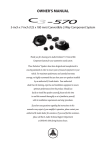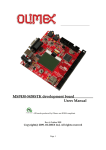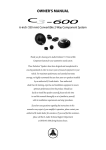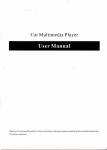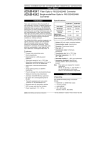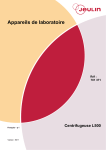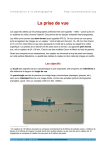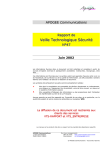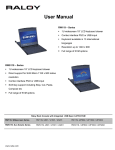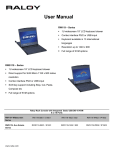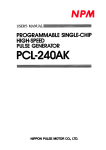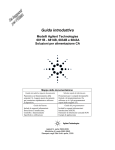Download Model DH1715 dual—Channel Regulated Voltage/Current Power
Transcript
Model DH1719A Regulated Voltage/Current Power Supply User’’s Manual User Dahua Company of Electronic Instrument in Beijing Dah 1 CONTENTS Description 1. Operating Features 2. Operating Principle 3. Structure Features 4. Applications 5. Maintenance 6. Completeness of the Instrument 7. Storage 8. Guarantee 2 DESCRIPTION The Model DH1719A Regulated Voltage/Current Power Supply is an automatic switching type of high accuracy CV/CC power supply with a 3 1/2 digits display meter on the front panel. The output voltage and the output current can be displayed by ON /OFF switch on the front panel. This instrument provides a preset circuit and an output switching circuit, the output switch is an electronic type, which does not generate chattering and noise. When the output switch is set to “OFF” state, the value indicated by the output voltmeter corresponds to the position of the voltage setting knob so as to preset the voltage. Press “OUTPUT” switch, the output voltage is available from “OUTPUT” terminal. The operating modes of CV and CC are displayed by a digital LED meter on the front panel. The red lamp indicates CC (constant current), the green lamp indicates CV (constant voltage). This instrument has function of the remote-controlled voltage. The input socket on the rear panel is controlled remotely. Please carefully read this instruction manual before use the power supply. 1. OPE RATING FEATURES OPER Model INPUT Input Power Supply OUTPUT Output Voltage (10-turn) DH1719A-2 24V-5A DH1719A-3 32V-4A ≤200VA 0-24V 0-32V Theoretical Value of Voltage resolution 0-55V 0-5A 0-4A 0-2A Adj. Ratio CV FEATURE 1×10-5+1mV Load Effect 1×10-5+2mV 10V/24 Adj. Ratio CC FEATURE Source Effect (line regulation)(for ±10% change of line volt) Load Effect(load regulation) (for 0-100% change of load resistance) Ripple and Noise (5Hz-1mHz) r.m.s Remote Control (Con. Voltage/Output Current) CV Mode Indication CC Mode Indication Operating Temperature Rang Relative Ambient Operating Humidity Range Storage Temperature and Humidity Range Cooling Method Polarity of Output Voltage 0-100V 5mV Source Effect (line regulation)(for 0-100% change of output current) Ripple and Noise(5Hz-1MHz) r.m.s Type. Value of Temp. Coe. Remote Control (Control Volt./Output Volt.) DH1719A-5 100V-1A 220V±10% 50Hz±5% Power Dissipation (200VAC),Rate Load Output Current(1-turn) DH1719A-4 55V-2A 1mV 2×10-4℃ 10V/32V 10V/55V 0-1A 10V/100V 2mA 10mA 10V/5A 1mA 10V/4A 10V/2A C.V Indication(Green LED) C.C Indication(Red LED) 0-40℃ 20-90%RH Unforced air cooling positive or negative grounded 10V/1A 3 Continue: DH1719A-2 24V-5A Model DC VOLTMETER Range Selection DC AMMETER Full Scale (Fixed Range) DH1719A-3 32V-4A DH1719A-4 55V-2A DH1719A-5 100V-1A ±(0.5%rdg + 3dgts, at 20±2℃ and < 80%RH Accuracy of Voltmeter Maximum Allowable Application Voltage Ammeter Accuracy(at20±2℃ and<80%RH) ±1rdg + 5dgts (+400×10 )/℃ full-scale + the accuracy mentioned above Not greater than 3dgts within 0-40℃ 2A -6 Temperature Coe. Zero Drift Input Fuse Output Fuse Weight External Dimensions Reliability of the Instrument ≤8kg 305(L)×200(W)×170(H)mm MTBF (θ)≥5000 hours RATING PRINCIPLE 2. OPE OPER The feature of this power supply is that the output voltage signal of constant Voltage circuit and the output current signal of constant current circuit both are applied to the “GATE” circuit at the same time. According to requirement of the load, the power supply is determined to operate in the CV mode or in the CC mode, the automatic switching of the regulated voltage and the regulated current can solve the problems of over—current protection of the regulated power supply and the over—voltage protection of the regulated current power supply. CONTROL CIRCUIT: It is an adjustable reference voltage generator. The output current and voltage depend on setting the reference voltage. Relay Switching and Aux. Supply Circuit Output Switch Circuit Reference Voltage Transformer CV Diff. Ampl + Amplify Control Circuit Gate CC Diff Ampl + Remote Remote Control Circuit Control Signal A/D Conv Rectify and Filting Series Setting Current Sampling AC 220V Voltage Sampling DC Meter Circuit Figure 1 4 2.1 Description of Constant Constant--Voltage Mode The reference output voltage circuit is applied to the negative input terminal of a CV error amplifier, the error voltage from the voltage sampling resistor is applied to the positive input terminal of the CV error amplifier. The error signals of both voltages are compared each other and via the gate circuit by amplify then applied to the base of a regulated tube. The base current of the regulator tube is changed, then a stabilized output voltage can be obtained, the adjustment of the output voltage is realized by setting the voltage potentiometer on the front panel. Constant--Current Mode 2.2 Description of Constant The reference voltage from the control circuit is applied to the negative input terminal of a CC error amplifier, the current signal from A/V conversion is applied to the positive input terminal of the CC error amplifier. Both signals are compared each other and then amplified to control the base voltage of the regulator tube to reach a stable current output. Conversion--CV mode into CC mode 2.3 CV/CC Conversion Setting CC potentiometer, a preset current value is provided as required, the resistor load is reduced, the output current is increased. When the output current reaches the preset constant –current value, the output voltage is reduced. In this case, CV lamp goes off, and the CC lamp lights. But when the power supply is power supply is operating in the constant-current mode, even of the resistor load value is reduced to zero(in short circuit state), the output current can not be increased, it always keeps pre-setting value constantly; that means this instrument can automatically be converted from constant-voltage mode to constant current mode so as to protect the load from over-current. It is an automatic CV/CC crossover system type of power supply. The Figure 2 shows operating points and operating domain related to the load lines. The preset output voltage is 10V, the limited current is 2A, the operating point in non--load is at A, when RL=10 Ω , operating point B, and when RL=5 Ω , operating point is at C. The operating point moves from C to D ,if the resistor load is reduced from RL=5Ω to 2.5Ω,the instrument operation is changed from the constant—voltage domain into the constant—current domain. Point C is called “ Crossover Point” owing to change modes. Wen the resistor load (RL) is 2.5Ω,the output voltage is I. RL=2×2.5=5V. 2.4 CC/CV Conversion-Constant Current Mode into Constant-Voltage Mode Setting CV potentiometer, a preset value applied as required. When the output voltage reaches the preset constant voltage value, then output current is reduced, while the CC lamp goes off, the CV lamp lights. When the output current is 2A the resistor load is 0Ω,operating point is E. While the resistor load is increased to 2.5Ω,the operating point moves from E to D. When the operating point is increased to 5Ω, the operating point moves from D to C. While the resistor load further is increased to 10Ω , the operating point moves from C to B. In this case, the instrument is converted to the constant-voltage domain. When the resistor load is increased continuously to an open circuit, the operating point moves from B to A . Generally, the voltage applied to the load is not more than the preset voltage. The instrument can convert from the CC mode to the V mode in order to protect the load. The point C serves as a crossover point. E0 10V A B C RL=5Ω Load Line RL=10Ω 5 2.5 Output Switching Circuit This instrument provides a special output switch, the output voltage can be preset as required before the switch is unpressed. After the voltage is adjusted, press the switch. This switch is an uncontacted electricity type of switch so it does not generate a mechanical spark, protecting users’ safety. 2.6 Digital Display Model TY– 43 digital meter adopts LED digital tube as display unit. At least, one or two digits generated by the display may flicker. It is not caused by the wareform or noise of output, while by characteristics of the A/D convertor. When there is no input voltage, the display will be recovered to zero automatically. When the input voltage, is inverse, “-” polarity will be displayed automatically. When the operating voltage is 5V, its input sensitivity is DC±199.9mV of full-scale. 3. STRUCTURE FEATURES The instrument is designed symmetrically between left and right on the front panel. On the upper side, there are two digital meters. Down the meter, there are two indicating lamps, one is for CV mode (green), the other is for CC mode (red). A switch for output on the right of the panel is mounted. There are two knobs in line as voltage potentiometer of each circuit, and current setting potentiometers . The two external sockets are mounted in the middle or lower part of the panel and at the bottom of the panel there are a pair of output binding posts and a screw grounded with a short bar. When “+” or “-” to ground is needed, we can connect the short bar. On the bottom of the panel is L/R (local/remote control) operating selector switches, respectively. At the lowest bottom of the instrument’s back, there are one power cord and two pairs of input sockets for the remote-control signal corresponding to the two ways on the front panel. There is V/C (voltage/current control) operating selector switches, respectively. The input fuses both are mounted on the rear panel of the instrument. 4. APPLICATIONS 6 4.1 Before operation, should check L/R (local/remote control) selector whether on its right position or mot, otherwise it doesn’t operate, generally it is at ‘L’ position. 4.2 Turn on the power supply, press the “V” button by adjusting the voltage setting potentiometer to a required voltage value and then press the “OUTPUT” button. While the voltage is available at the binding post, at the moment, the CV lamp (green) lights, the constant-voltage mode starts operating. If the CC lamp (red) lights, the voltage value drops, in this case the instrument is in constant-current Mode, should set the CC setting potentiometer to the extreme position clockwise. 4.3 Preset a constant–current point and set the output current of the unit. By above, mentioned method, after the constant-voltage point is set, press the “A” button and output terminal is shorted, turn on the “OUTPUT” switch, then the CC lamp lights, but CV lamp goes off. After the current setting potentiometer is set to the required value. To keep the voltage position, turn off the “OUTPUT” switch and remove the short bar, connect the 1oad, press the “ OUTPUT” switch, the instrument provides the required current and voltage for the load. V Voltage C Current Figure 3 4.4 When turn off the power supply, first should turn off the “OUTPUT” switch, then turn off 4.4 the “POWER” switch. 4.5 Remote–Control CV Output The output voltage can be controlled by an external voltage of 0-10V. As the externa1 contro1 signal, its common termina1 is a “+” n output terminal. 4.5.1 Turn on the R/L (remote/loca1) selector switch to R position. Turn on the V/C (voltage/current) selector switch to V position. 4.5.2 Turn on the “POWER” switch and the “OUTPUT” switch, the external control voltage is applied through the jack on the rear panel of the unit. Adjust “VOLTAGE” switch of the potentiometer to the extreme position clockwise, adjust the external control voltage so that the output voltage becomes the desired voltage. The relationships between the output voltage (Eo) and the external control voltage (El) is expressed as follows: Eo=1/10 Emax.E1.a (V) Where Em: Maximum rated voltage (V) El: External control voltage signal (V) 0V ≤E1≤<l0V 7 Term α is factor of 0-l which depends on the “voltage” setting potentiometer. Factor is 1 when “VOLTAGE” voltage setting potentiometer is set to the extreme positions clockwise. Factor is 0 when both potentiometers are set to the extreme positions counterclockwise. It is used to select the ratio of the output voltage (Eo) with respect to the external control voltage signal (E1). Norma1ly, it is adjusted to the maximum vo1tage. NOTE 1: The vo1tage of the common line of the external control voltage signa1 (El) becomes that of the “+” output terminal. NOTE 2: The input impedance across remote control input jack is approximately 20KΩ. The ripple may be amplified and conveyed to the output loop circuit. NOTE 3: To feed the external control vo1tage signal, a shielded cab1e (or a pair of stranded wires) is used and the shielding wire is connected to the “+” output terminal. When the wiring distance is very long, should prove a full protection against noise. NOTE 4: When the R/L (remote/local) switch is thrown to the L position, the output voltage can be control1ed with the voltage setting potentiometer manually on the front panel. NOTE 5: Make sure that the output voltage is within the rated output voltage of the instrument. 4.6 Remote Control Constant-Current Mode The output current can be controlled by the external contro1 voltage signal 4.6.1 Turn on the V/C (voltage/current) selector switch to C position. 4.6.2 The external control voltage signal is applied to the “INPUT” jack which is on the rear panel of the instrument. Please note the po1arities of “+” and “-”. 4.6.3 Throw the R/L-switch to R (remote control) position. 4.6.4 Turn on the power supply and output switch, then the output terminal is shorted, set the current setting potentiometer mounted on the front panel to obtain the required output current which is 10V at E2. In remote control mode, the CC lamp still lights. Output L Remote Control Input NOTE 3 R E1 NOTE 1 NOTE 2 NOTE 4 Figure 4 The relationships between the external control voltage signa1 E2 and the output current I0 can be expressed as fo1lows: I0= 1/10. Imax E2.β(A) where: Imax – Maximum rated current (A) E2 – External control voltage (V) 0(V) ≤ E2≤ 10(V) Range of isβ0–1 which depends on the current setting potentiometer, when it is turned to 8 the extreme position clockwise, 0 is l, while it is turned to the extreme position counteclockwise, β is 0. Within the range of the factor, by adjusting the externa1 control signal (E2) can performer the proportional relation of the setting output current Io. NOTE 1: For wiring of the external control voltage signa1, use a shie1ded cable (or a pair of stranded wires). NOTE 2: When the R/L-switch is thrown to L (local) position, the output current can be controlled by the current setting potentiometer on the front panel manually. NOTE 3: Pay attention to that the output current does not exceed the rated current, be sure disconnect the short bar on the front panel. Remote Control Input Output L NOTE 1 R E1 NOTE 2 Figure 5 4.7 Series Operation To obtain a higher vo1tage, two or more instruments can be connected in series. In order to eliminate potential difference among the chassis of units being due to connecting in series, disconnect the ground bars of the units and connect the ground terminals together to the same potential as required. ATTENTION: The total series vo1tage should not exceed 200V. 4.8 Paral1el Operation In order to obtain a large output current, two or more instruments can be connected in parallel, then adjust their output voltage to the same voltage leve1.If differences of the output voltage appears, the current initia1ly is fed by the unit which is set at the highest voltage. When the load current becomes more, it wil1 be converted to constantcurrent operating mode, in this case, the output voltage will be reduced. In this moment, the power supply with the higher output voltage wi1l start operation. The tota1 output current of the instrument is the sum of current of each unit. NOTE 1: Pay attention that the output voltage of each unit does not exceed the rated voltage. NOTE 2: For the instrument, the output voltage setting is too low, the current of several milliampers will flow in the reverse direction. 4.9 Parallel Operation of Single Unit In order to increase current capacity, a master unit is used to control several slave units remotely. Method is the same as Section 4. 6 Remote–control CC Mode The output of the master unit (power supply) is 0–l0V controlled vo1tage. The slave units are operating in remote–control constant–current mode Master Remote Control Input Ground Slave L1 Remote 9 4.9.1 Each slave unit should be previously connected with the master unit in remote control CC operation, and then adjust the current setting potentiometer to the extreme position, making factor ɑ = 1. If differences of the slave unit appear, should trim the current setting potentiometer. 4.9.2 Connect the output terminals of all units to the load, using wires of same gauge and the same length. Note that the current distribution may ununform unless the potential different between the “+” output terminals of the instruments and the “+” terminal of the load are the same. The slave units are connected in paral1eI as shown in Fig. 6. 4.9.3 Throw R/L switch to R position. The current setting potentiometer is set to the extreme position 4.9.4 Turn on the “OUTPUT” switches of all s1ave units. 4.9.5 Turn on the “OUTPUT” switch of the master unit and adjust the control voltage (<10V). NOTE: All the parallel slave units must be the same types. When the instrument is operating in remote-control CC mode, the cc lamp always lights. Ground Master E1 R L Ground Slave E2 L R Ground Slave E3 L R1 Remote Control Input R2 Remote Control Input R Figure 7 Load 4.10 Control Series Operation of Single Unit (Dual–tracking Power Supply Operating Mode). The instrument is connected in series and controlled by one master unit. The s1ave units can 10 be controlled to increase the output voltage of the setup (uppermost one of the instrument connected in series operates as the master unit). 4.10.1 Except that the master unit is operating in “L” (local) state, all the slave units are in the state of the output voltage controlled by the external voltage signal, that means the master unit’s R/L (remote/local) selector switch is thrown to “L” position, while the switch of the slave unit is turned to “R” position. V/C (voltage/current) selector switch is thrown to “V” position. 4.10.2 All the output terminals of the power supply are in series connection shown Fig8. 4.10.3 On the top of the Figure is a master unit. Resistor R1 is connected to “+” output terminal of the uppermost unit and the remote–control input jack of the first slave unit. Resistor R2 is connected between the remote contro1 “–" input terminal of the first slave unit and the remote–control “ +” input jack Of the second s1ave unit. 4.10.4 The voltage setting potentiometer and current setting potentiometer are turned to the extreme positions of each s1ave unit clockwise. 4.10.5 All the “GROUND” terminals of the instrument are connected to one common line which is connected to a potential line as required. 4.10.6 Turn on both “POWER” and “OUTUPUT” switches of the master unit and the slave unit. NOTE: (1) For the remote–control operation, it is necessary to control the master unit only. (2) Position of 1imiting current of all units must be preset previously. (3) Calculation of resistors R1(R2). (4) When this instrument is operating in CV mode, the CV lamps (green) both of the master unit and the slave unit light. R1= E1/E2 .x A–10KΩ where: R1≥0 or E2≤A/10×E1 R1(R2) external1y connected resistor (KΩ) El: Output vo1tage of the master unit (V) E2: Output voltage of the slave unit 2 (V) If E1=E2=E3, then R1 =R2 (5) Maintenance of the Instrument Rated Voltage 24V System 32V System Coefficient A 24 32 55V System 55 100V System 100V 5. MAINTENANCE 5.1 Inspection Inspect the instrument at regular intervals so that it maintains its intia1 performance for a certain period. 5.2 Removing Dust and Dirt and Clean Treatment When the panel has become dirty, wipe it 1ightly with a cloth moistured and a neutra1 soapsud, and then wipe it with a clean dry cloth. For c1eaning the inside of the instrument, remove dust from the inside of the case and ventilation holes of the cover by using a compressed air or the exhaust air of a vacuum cleaner. Be carefully when cleaning dust of the 11 digital meter and always keeping it cleaning. 5.3 Adjustment and Calibration of the Meter RVl: Voltmeter calibration potentiometer for voltage precision. RV2: Maximum voltage setting potentiometer RV3: Maximum current setting potentiometer RV4: Maximum current setting potentiometer for voltage presetting RV5: Ammeter zero–setting potentiometer RV6: Current meter calibration potentiometer for current precision RV2 RV3 RV4 RV1 RV5 RV6 Figure 8 5.4 Ca1ibration of Voltage Indication 5.4 (1) Connect a digital voltmeter with accuracy ≥0.05% to the output terminal. Turn on “OUTPUT” switch, adjust the output voltage to 17. 50V. (2) Adjust potentiometer RV4 so that the digital meter indicates approximately the same voltage. 5.5 Calibration of Ammeter (1) Press A button (ammeter) switch and turn off “OUTPUT” switch. (2) Adjust potentiometer RV5 so that the digita1 meter shows 0A (zero amperes) (3) Connect an ammeter with accuracy ≥0. 2% to the output termina1, turn on OUTPUT switch, and feed the current, after feeding the current for approximately 20 minutes, calibrate the output current with potentiometer RV6 so the indication on the digital meter is the same as the standard ammeter. 5.6 Adjustment of Maximum Variable CV Range (1) Press V (Voltmeter) switch and turn on “OUTPUT” switch. (2) Turn voltage setting potentiometers to the extreme position clockwise, adjust potentiometer RV2, so that the output voltage becomes E0 (maximum voltage) as specified. 5.7 Adjustment of Maximum Variable CC Range. (1) Connect an ammeter with approximate1y accuracy of 0.5% to the output terminal. (2) Set the potentiometers to the extreme positions clockwise, adjust potentiometer RV3 so that the output current becomes Io (maximum current), refer to tab1e 2. Rely turn on Rely cut-off 0 E0 Output voltage 5.88 Calibration of Digital Meter 5. Press down the output switch, checkFigure the voltage accuracy in the subranges of 2V, 20V, and 9 12 set RV1 to required secifications. Table 2. Model Adjustment DH1719A-2 24V-5A DH1719A-3 DH1719A-4 DH1719A-5 32V-4A 55V-2A 100V-1A 5A 4A 2A 1A Max. Variable CV Setting Range E0 (max.) 25.2V 33.3V 57V 105V Max. Variable CV Setting Range I0 (max.) 5.2A 3.15A 2.1A 1.05A setting of Relay Switch 14V 20V 33V 60V Calibrated. Standard Ammeter I1 Circuit 5.9 Failure and Cause 5.9 5.9.1 Without Voltage Output (1) The±15V Aux. Power supply does not work. (2) The Local/Remote (R/L) switch position is not correct. (3) The output switch is not turned on. 5.99.2 The output voltage can not be set up to the required value. 5. (1) The CC point is turned to low, it should be turned to higher. (2) The output terminal has been shorted. (3) On the PC boards Q1or Q2 may be damaged. 5.99.3 Unstable Operation 5. (1) ±15V voltage of the aux. Power supply does not stabilize. (2) V3 or V4 on the PC board does not operate normally 10 Normal Operating Voltage of the Instrument 5.10 5. The “+”output terminal is a reference point when the instrument is measured. 10 .1 The voltage of the aux. power supply is ±15V. 5.10 5. 10.1 10 .2 The voltage of each measured point on the PC board. 5.10 5. 10.2 V2= 6. 1v REFV = 0~-10V REFC = 0~-10V CCAMP= 0~ - 10V When operating in CV mode: C.V = 0~4v C. c = +14V When operating in CC mode: C.V = +l4v C. c = 0~4v 6. COMPLETENESS OF THE INSTRUMENT The instrument suite includes: (1) DHl719A master unit (2) Cartridge fuse BGxP Φ5x20 Input fuse 2A (3) Instrument Manual l set 2 2 13 7. STORAGE The instrument should be save up in a ventilated room where the ambient temperature is 545℃, RH ≤90% and dew is not allowed. These conditions are needed to protect the 1iquid crystal display, in addition, keep the instrument from smoke, gas, acid, alkaline and other corrosive materials, be sure not to place the instrument in high temperature and more dust place so as to keep the instrument clean. After delivery within 18 months, if the users abide by the regulations of transportation, storage and operation regulation, and the quality is below the specification, our company take responsible for free repair or rep1ace a new one. 14















